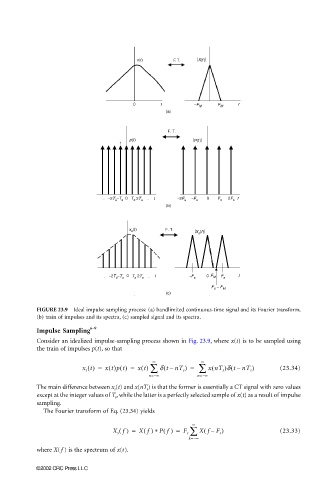Page 709 - The Mechatronics Handbook
P. 709
0066_Frame_C23 Page 17 Wednesday, January 9, 2002 1:53 PM
FIGURE 23.9 Ideal impulse sampling process: (a) bandlimited continuous-time signal and its Fourier transform,
(b) train of impulses and its spectra, (c) sampled signal and its spectra.
Impulse Sampling 6–9
Consider an idealized impulse-sampling process shown in Fig. 23.9, where x(t) is to be sampled using
the train of impulses p(t), so that
∞ ∞
x s t() = xt()pt() = xt() ∑ δ tnT s ) = ∑ xnT s )δ tnT s ) (23.34)
(
(
(
–
–
n=∞ n=∞
–
–
The main difference between x s (t) and x(nT s ) is that the former is essentially a CT signal with zero values
except at the integer values of T s , while the latter is a perfectly selected sample of x(t) as a result of impulse
sampling.
The Fourier transform of Eq. (23.34) yields
∞
(
X s f() = Xf() ∗ Pf() = F s ∑ Xf F s ) (23.33)
–
k=∞
–
where X( f ) is the spectrum of x(t).
©2002 CRC Press LLC

